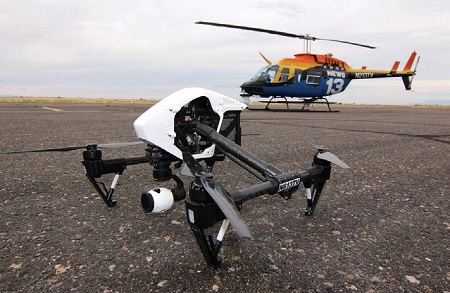Broadcasters Adding Drones to ENG Kits
OTTAWA—Even under the FAA’s highly restrictive “333 exemption” rules governing the commercial use of drones—especially the requirement to file flight plans 24 hours before launch—pioneering broadcasters such as ABC News, Cox Media Group, and Media General have managed to capture exciting, meaningful TV coverage using these unmanned, camera-equipped platforms.

Media General station KRQE-TV in Albuquerque, N.M., uses both drones and its helicopter for ENG. “The damage caused by hurricanes, tornadoes, flooding and earthquakes becomes very clear from 100 feet in the air,” said Maria Stefanopoulos, production manager for “Good Morning America.” “This is a hard message to convey by using an ENG crew on the ground.”
Recent compelling drone news footage includes New York ABC O&O WABC-TV’s drone footage of severe storm damage on Long Island, Jacksonville, Fla.; Cox Media Group’s WJAX-TV’s overhead views of the area where the remains of missing two-year-old Lonzie Barton was found, and Media General’s KRON-TV’s after-event coverage of wildfire devastation in the San Francisco area. Add “Good Morning America”’s use of drones to explore Son Doong Cave in Vietnam during a live broadcast, and the “wow factor” of drone footage is simply undeniable.
“This past February, GMA went on another epic drone expedition, this time in Ngorongoro Crater in Tanzania where two drones and three other cameras were launched on a mission to highlight animals near extinction,” said Stefanopoulos. “These flying cameras came face to face with lions, elephants, hippos, ostriches and rhinos, all in their natural habitat. Before drone technology, showing the world these marvels wouldn’t have been possible.” (See also “Drone Action Heats Up,” about GMA’s drone coverage of an Icelandic Volcano, in the April 1, 2015 issue of TV Technology.)
As of August 28, 2016, the FAA’s rules on drone usage have been significantly relaxed under the agency’s new Part 107 regulations. In particular, TV stations will no longer have to file a flight plan 24 hours in advance; making the coverage of breaking news using drones legally possible, (see “FAA Clears Way for News Drones,” July 2016 TV Technology).
Nevertheless, the remaining FAA conditions plus the extremely costly legal ramifications of drone-caused injuries to the public means that the detailed strategies used by U.S. drone newsgathering pioneers demand serious study by any TV station wanting to launch their own “eye in the sky.”
STILL CAUTIOUS
Get the TV Tech Newsletter
The professional video industry's #1 source for news, trends and product and tech information. Sign up below.
Even without the FAA’s rules, safely flying HD camera-equipped drones like the DJI quadcopters used by ABC News, Cox Media Group and Media General is not a task for amateurs. This is why all of these news organizations spent months planning out their approach to flying and downlinking footage from newsgathering drones.
At Media General, for instance, “we formed a six-person task force that included news directors, chief engineers, and news photographers to plan our end-to-end drone strategy,” said Brett Jenkins, Media General’s CTO. As a result of this process, Media General opted to have its pilots complete a drone training program that included simulator training and flight skills training. In the field, they created workflows that included both file-based and live options with the video footage being downlinked on location to either a TVU backpack or an ENG truck.
ABC News has also done some training on the use of drones, according to Brian Kennedy, ABC News’ vice president of Global News Gathering & Planning. “We have done a complete training program encompassing everything from maintenance to flying,” he said. “This is meant to give a full picture of how you can fly, where, when, and under what conditions; and it also gives the practical skills to fly safely, including reaction to unexpected situations. We have also done a shorter executive class designed to teach those who may never fly, but who need to know the capabilities and procedures of this technology and our program.
Given that the FAA’s 333 exemption rules required 24-hour flight plans to be filed before takeoff, “most news directors were seriously disappointed that we couldn’t use drones for breaking news,” said Media General’s Jenkins. “But even under those rules, we were able to use drones for follow-up overhead news video and also for non-news uses such as beauty shots for local advertisers.” These benefits, plus the promotional advantage of Media General stations being able to promote that they had drones when their competition didn’t, made the investment worthwhile.
“WJAX’s use of our ‘Action News Jax’ Skyvision drone has made a big impression on our viewers,” said WJAX-TV News Director Bob Longo. “The first big splash was when we flew over the Florida search area for Lonzie Barton’s remains,” he said. (Barton’s accidentally drowned body was disposed of by his mother’s boyfriend Ruben Ebron, who initially claimed the toddler was kidnapped when Ebron’s car was stolen.) “Being able to provide an overhead view provided a unique perspective to the story, which we couldn’t do from the ground.”
“We feel that drone video, whether live or taped, has given us a chance to tell our stories in new and compelling ways,” said Jennifer Graves; ABC 7 Chicago’s vice president and news director. “The video from the drone is usually more intimate than video from our helicopter. And in some cases, like the video we shot inside a Chicago-area quarry that will be used for floodwater control, the drone shot scenes that we would not be able to capture any other way.”
PROPERLY TRAINED PILOTS
Now that the FAA’s Part 107 rule eliminates the need to file flight plans 24 hours prior to drone takeoff, news organizations such as ABC, Cox, and Media General will be able to leverage their drone platforms to cover breaking news. But this doesn’t mean that they will take risks, such as flying unheeded over the public, or interfering with manned aircraft traffic. As well, these organizations’ insistence on using properly trained pilots will continue.
A case in point is ABC News: “With Part 107, we have a two-phase training program,” said Kennedy. Phase One is “a ground school designed to prepare producers and camera people to fly drones, understand the rules and conditions, and prepare for the FAA certification requirement. Once FAA-certified, we require the flight school to prove you are capable of flying the drones/UAS we are using and be sure you understand our systems and procedures. Once trained, it is very important for people to practice frequently to keep skills sharp.”
As for drones’ place in overall TV newsgathering? “We see drones as being a part of our overall toolkit, but not a replacement for helicopters or ground ENG crews,” said Jenkins. “I’m hoping it’ll be one of our go-to tools,” added Graves, “but a lot will depend on how the rules and regulations, both at the federal and local level, evolve.”
That said, the FAA’s Part 107 rule with its relaxed requirements will definitely encourage many TV stations to buy their own drones and start shooting. For those about to make this move, ABC News’ Stefanopoulos offered the following advice: “Safety is the number one priority. Education is critical. Practice, practice, practice.
“Operating drones is not for everyone,” she added. “Rules need to be obeyed 100 percent of the time and these machines need to be treated with the utmost respect. As television producers, we like to push the envelope to get the most creative and the most cutting edge images, but when a drone is in the air, the producer is no longer in charge. Finding a team who is passionate about this technology and who understands the advantages and limitations of flying cameras is key.”
James Careless is an award-winning journalist who has written for TV Technology since the 1990s. He has covered HDTV from the days of the six competing HDTV formats that led to the 1993 Grand Alliance, and onwards through ATSC 3.0 and OTT. He also writes for Radio World, along with other publications in aerospace, defense, public safety, streaming media, plus the amusement park industry for something different.

